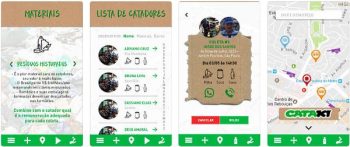By Allie Kuo
Wittily described as the Tinder for recycling, Cataki is an app that connects Brazilians to their local catadores, or waste pickers. Developed in 2017 by street artist and activist Thiago Mundano, Cataki seeks to increase the visibility and appreciation of the catadores who play vital roles in maintaining public areas but are mostly overlooked. By combining the swiping features of the familiar dating app and the map function that Uber utilizes, this app is changing the way people think about recycling and their relationships with essential workers in their communities, starting in São Paulo.
According to a 2017 article from The Economist, the city tosses 12,000 tons of waste daily and only 300 tons are recycled, despite regulations that say municipalities must process recyclable garbage on their own. However, with the help of over 400,000 catadores across the country, according to Netexplo, four-fifths of the cities’ waste is collected and recycled for a small profit.
Despite the importance of these individuals’ role in making sure the streets of Brazil aren’t overflowing with garbage and recyclable materials aren’t being thrown into landfills, the catadores face a harsh stigma as they are often the poorest members in communities and are constantly overlooked or treated with disrespect. This is where Cataki comes in to break down those social barriers and connect groups that may not have had an opportunity to interact otherwise.
Catadores create an online profile, with basic information like their name and a photo of themselves, and their location becomes visible on a map. This map is complete with small purple icons of their waste pick-up carts which users can access. It gives catadores the option to choose where and what they want to pick up, because people can post about the waste that they have and even include a photo. The app does not take any money that the catadore receives, and payment is suggested but left up to negotiation between the two parties.
 This changes the dynamic for those low-income workers who are finally getting some recognition for the labor-intensive and time-consuming work they do to support their families. Cataki also helps develop fixed collection points, which could mean repeat customers who bring in a steadier income for the catadores. By making resources available for both the workers and the consumers, the waste pickers are able to reach a broader market and be compensated for the work that they are doing, instead of having to depend on the minimal amounts they get from selling cans and other recyclable materials to scrap merchants.
This changes the dynamic for those low-income workers who are finally getting some recognition for the labor-intensive and time-consuming work they do to support their families. Cataki also helps develop fixed collection points, which could mean repeat customers who bring in a steadier income for the catadores. By making resources available for both the workers and the consumers, the waste pickers are able to reach a broader market and be compensated for the work that they are doing, instead of having to depend on the minimal amounts they get from selling cans and other recyclable materials to scrap merchants.
The app’s name comes from cata-aqui, meaning “come here”. It serves as a beckoning call from people who want to dispose of their recyclable waste, and helps catadores answer that call in a dignified and connected way. João Ferro, the Head of Communications for Pimp My Carroça which is the NGO behind Cataki, sums up why the app is so important in bridging the gap between community members and the catadores that essentially work for them.
“Waste pickers often suffer from a very cruel social stigma. But a person who stops to look him in the eyes and talk to him for three minutes will never see this profession in the same way. After that, it’s highly unlikely that this person is going to honk at a waste picker on the street,” said Ferro.
Over 400 catadores from 65 Brazilian cities have joined the platform, according to a 2018 article from the Australian Broadcasting Corporation. Of course, this is just a tiny fraction of the hundreds of thousands of workers across the country, but Mundano hopes that a continual growth and adaptation of the app can lead to social change for the 1% of the population making a living from peddling and scavenging.


